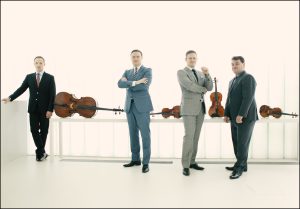
By Ava Figliuzzi
The Chamber Music Society of Palm Beach closed its 10th annual season April 21 with the lauded Jerusalem Quartet. The Kravis Center’s Rinker Playhouse was filled out nicely for the Friday evening program of Felix Mendelssohn’s String Quartet No. 4 in E minor (Op. 44, No. 2) and Tchaikovsky’s First String Quartet (in D, Op. 11).
Since their 1996 debut, the veteran players have earned several awards for their recordings, including the Diapason d’Or and the BBC Music Magazine Award for chamber music. Their most recent international appearances have taken them from Wigmore Hall to the Berlin Philharmonie as well as a residency at the Jerusalem Academy of Music.
With quartets of this caliber, an instinctual flair brings novelty to familiar classics. Each member of Jerusalem spoke his mind, with the somewhat unblended but enjoyable outcome of four audible personalities rather than a curated homogeny. Most notably, cellist Kyril Zlotnikov’s demonstrative playing often came to the foreground — at times over the melody. The directness of his tone and youthful energy steered the quartet from the bottom up. Paired with a robust viola sound from Ori Kam, Jerusalem’s lower voices provided a powerful delivery.
Some restraint in sheer power could have distinguished the style of Mendelssohn from Tchaikovsky. Insistent eighth notes in Mendelssohn’s first movement opening theme were elongated, while more lifted, separated strokes would be better suited to the early Romantic period and agitato character. Later, exuberant chords punctuating Tchaikovsky’s first and final movements seemed too clipped for a late-Romantic behemoth.
First violinist Alexander Pavlovsky initiated the opening Allegro assai appassionato in the Mendelssohn quartet with intense vibrato and a pulsing portato that created a foaming, nervous energy while keeping the sound resonant. The agitated character was satisfying to hear with the syncopated inner voices.
What the following Scherzo lacked in lightness it achieved in phrases that effectively scaffolded the movement’s excitement. Strong lower voices gave the pleasing effect of motives bouncing around, although all could have achieved more dynamics in the lower range, and the tone quality did not always match in imitative sections.
Particularly enjoyable in the Andante movement was the soloistic resonance from all members. With eyes closed, the glossy sheen of the notes and balanced chords had the unified finish of a recording — an impressive feat to experience live.
The Jerusalem’s strengths were a natural enhancement to the Tchaikovsky. Operating as a well-oiled machine, rubato and tempi fluctuations created a storyline without a single clumsy corner. The contrast between the opening movement exposition’s Largamente e cantabile and Poco più mosso sections showcased the quartet’s affinity for drama. A rough-and-tumble character was well-maintained throughout the high technical demands of the outer movements.
The beloved Andante cantabile second movement placed its heart on its sleeve. The chorale-like opening felt overdressed with Pavlovsky’s intense vibrato — a better variety of colors would have been appreciated. A more satisfying range was produced in the third movement Scherzo, where a boisterous opening paired well with an icier dolcissimo later on. Regardless, throughout the Andante cantabile, audible inner voices sung the harmonies to a lovely effect.
The Jerusalem Quartet’s finesse of a physically exhausting pair of works was made most enjoyable by the reckless abandon on display in the at-times frenetic Tchaikovsky. A tangible level of trust between all players allowed for theatrics to come alive as a celebratory conclusion to a decade of concerts from the Chamber Music Society of Palm Beach.